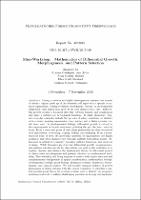| dc.date.accessioned | 2019-10-24T15:10:52Z | |
| dc.date.available | 2019-10-24T15:10:52Z | |
| dc.date.issued | 2015 | |
| dc.identifier.uri | http://publications.mfo.de/handle/mfo/3496 | |
| dc.description.abstract | Living structures are highly heterogeneous systems that consist of distinct regions made up of characteristic cell types with a specific structural organization. During evolution, development, disease, or environmental adaptation each region may grow at its own characteristic rate. Differential growth creates a balanced interplay between tension and compression and plays a critical role in biological function. In plant physiology, typical every-day examples include the petioles of celery, caladium, or rhubarb with a slower growing compressive outer surface and a faster growing tensile inner core. In developmental biology, differential growth is critical to the organogenesis of various structures including the gut, the heart, and the brain. From a structural point of view, these phenomena are close associated with instabilities, of twisting, looping, folding, and wrinkling. From a mathematical point of view, the governing equations of organogenesis are highly nonlinear and often characterized through multiple bifurcation points. Bifurcation is critical in symmetry breaking, pattern formation, and selection of shape. While biologists are studying differential growth, morphogenesis, and pattern selection merely by observation, our goal in this workshop is to explore, discuss, and advance the fundamental theory of differential growth to characterize morphogenesis and pattern selection by mathematical modeling. This workshop will bring together scientists with similar interests and complementary backgrounds in applied mathematics, mathematical biology, developmental biology, plant biology, dynamical systems, biophysics, biomechanics, and clinical sciences. We will identify common features of growth phenomena in living systems with the overall objectives to establish a unified mathematical theory for growing systems and to identify the necessary mathematical tools to address challenging questions in biology and medicine. | |
| dc.title | Mini-Workshop: Mathematics of Differential Growth, Morphogenesis, and Pattern Selection | |
| dc.rights.license | Dieses Dokument darf im Rahmen von § 53 UrhG zum eigenen Gebrauch kostenfrei heruntergeladen, gelesen, gespeichert und ausgedruckt, aber nicht im Internet bereitgestellt oder an Außenstehende weitergegeben werden. | de |
| dc.rights.license | This document may be downloaded, read, stored and printed for your own use within the limits of § 53 UrhG but it may not be distributed via the internet or passed on to external parties. | en |
| dc.identifier.doi | 10.14760/OWR-2015-49 | |
| local.series.id | OWR-2015-49 | |
| local.subject.msc | 92 | |
| local.subject.msc | 37 | |
| local.sortindex | 936 | |
| local.date-range | 01 Nov - 07 Nov 2015 | |
| local.workshopcode | 1545b | |
| local.workshoptitle | Mini-Workshop: Mathematics of Differential Growth, Morphogenesis, and Pattern Selection | |
| local.organizers | Krishna Garikipati, Ann Arbor ; Alain Goriely, Oxford ; Ellen Kuhl, Stanford; Andreas Menzel, Dortmund | |
| local.report-name | Workshop Report 2015,49 | |
| local.opc-photo-id | 1545b | |
| local.publishers-doi | 10.4171/OWR/2015/49 | |
| local.ems-reference | Garikipati Krishna, Goriely Alain, Kuhl Ellen, Menzel Andreas: Mini-Workshop: Mathematics of Differential Growth, Morphogenesis, and Pattern Selection. Oberwolfach Rep. 12 (2015), 2895-2910. doi: 10.4171/OWR/2015/49 | |

